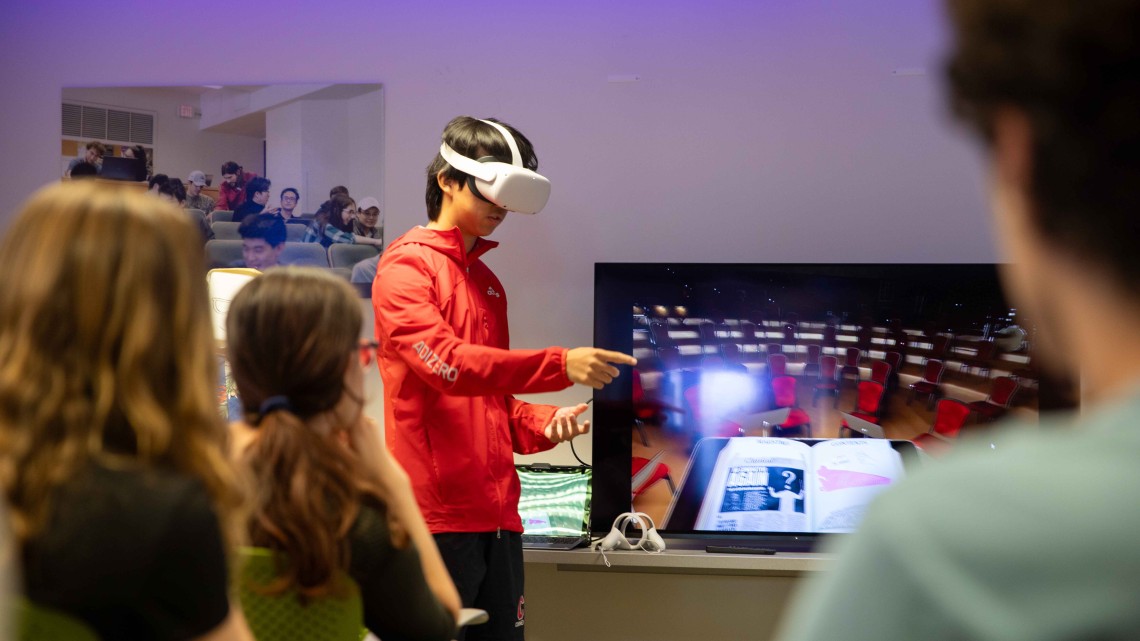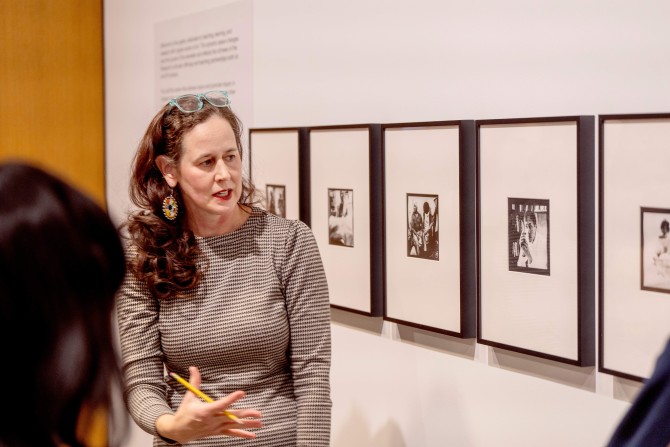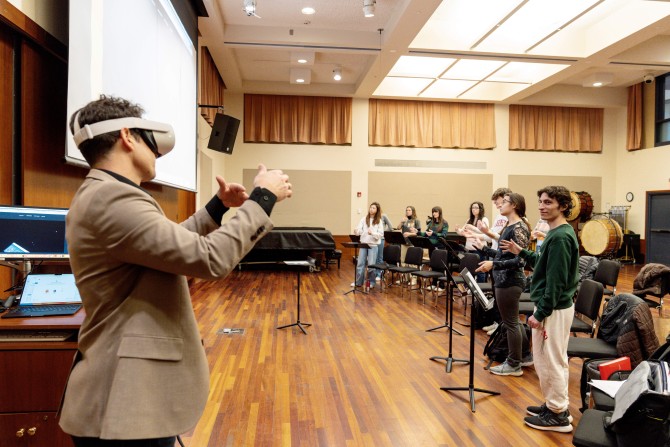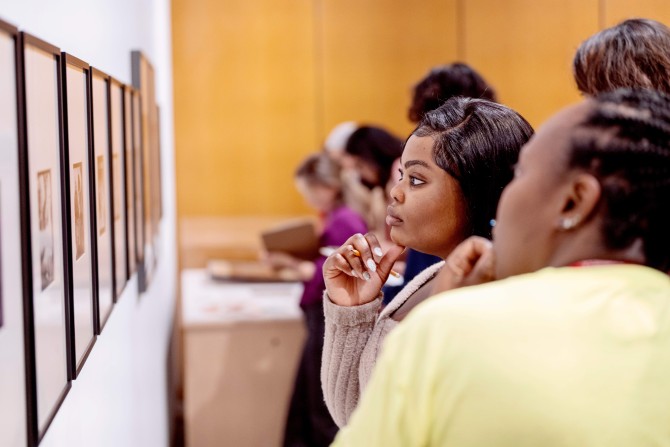
Students in James Spinazzola's conducting class attend a extended reality (XR) orientation to learn how the immersive technology can help give students a sense of what it feels like to conduct an ensemble in real time.
News directly from Cornell's colleges and centers
CTI grant recipients build student confidence, connection
By Carolyn Keller
Imagine conducting an ensemble, summoning a symphony with a flick of your wrist, creating a bridge between musicians’ talents and an audience’s imagination. Hidden are not just musical notes, but the precision, the training, and the hours of practice that create a performance – you can’t see them but they’re there, all coming to fruition in the form of shared musical experience.
Now imagine being a student learning the art of conducting. You pick up the baton, turn to your peers – and then what?
“When your peers are staring at you, waiting for instruction, it makes it hard to want to experiment, or create the sense of dynamism or play that brings music to life,” said James Spinazzola, Barbara & Richard T. Silver Associate Professor of music in the College of Arts & Sciences.
Spinazzola is one of the 2023-2024 recipients of an Innovative Teaching and Learning Grant, and one of two recipients whose projects this year focus on building empathy into their courses to promote student learning.
For Spinazzola, that means harnessing immersive technology to help students build the confidence they need to access their creativity as they learn to conduct an ensemble.
For recipient Jeanne Moseley, associate professor of practice in the Department of Public and Ecosystem Health in the College of Veterinary Medicine, that means integrating the arts and humanities into global and public education.
Moseley’s project, “The Art of Global and Public Health,” focuses on deepening student learning, expanding perspectives, building empathy and exploring creative responses to complex global and public health challenges.
Funded by the Center for Teaching Innovation, the Innovative Teaching & Learning Grants sponsor projects that explore new tools and emerging technologies and teaching strategies. Grants are awarded with an emphasis on each project’s potential impact and ability to be scaled and implemented more broadly on campus and beyond.
Last year, CTI awarded seven grants which are now progressing toward completion. For a full list of grantees and their projects, visit Innovative Teaching & Learning Grants.
James Spinazzola: Teaching Conducting in Extended Reality (XR) Environments
Few students, at Cornell or elsewhere, come to college with any conducting experience. As a result, the transition from sitting with an instrument to standing in front of an ensemble expecting leadership and direction can be difficult for students, who must learn a vocabulary of nonverbal gestures and movements, largely through instructor modeling, in-class exercises, individual practice, and peer feedback.
Even diligent practice in front of a mirror can only do so much to help prepare students for the challenge of leading a live ensemble, and Spinazzola has found students struggle with feeling self-conscious, overly self-critical, and vulnerable in front of the mirror or their peers.
Confronting this challenge by creating a low-stakes environment for students to practice was part of what led Spinazzola to apply for one of the CTI grants.
His project integrates virtual reality (VR) and immersive technology into his pedagogy, to give students a sense of what it feels like to conduct an ensemble in real time. The project’s immersive realities provided practice to help students overcome inhibitions and build confidence as they learned the art and language of conducting.
“It’s very hard – it’s unnerving,” Spinazzola said. “They have specific gestures and motions that they have to practice and they initially have no concept of how it looks or how it can be received by a musician. They kind of get the motion at first, but they have no point of reference as to how it would be perceived.”
Immersion through XR technology provides students with a low-stakes environment to practice in, allowing them to refine their conducting techniques, develop muscle memory, and virtually engage with musicians, all before they step to an actual podium to conduct live music.
With the headsets, students can learn the gestures that make up the vocabulary of conducting before standing in front of their peers to conduct and elicit the nuances of performance in real time.
As a result, students “can feel as though they’re on the conducting podium, but they’re actually just at the Tech Lab at school. They can go from practicing etudes and excerpts with the headsets to practicing etudes and excerpts with the ensemble,” Spinazzola said.
At this stage, the virtual reality footage is not interactive, so students are also expected to use other apps, including Maestro and Conductor Masterclass, to further help them practice.
But according to Spinazzola, the XR footage offers something unique: “They can conduct along with me and see what I’m doing, while also getting a better sense of the musicians and the geography.”
Spinazzola is now working to scale the project up. The flexibility of the technology also allows him to partner with colleagues, peer institutions, and professional ensembles, record their rehearsals and get their feedback on what he’s recorded in real time. Now that he has faculty feedback, he also hopes to obtain artist feedback and pedagogical feedback from other teachers.
“It’s a pivotal time, as I see it, in the development and widespread use of the technology. I think the more that the virtual reality format gains traction, the more colleges are going to be able to afford the equipment, and there will be a need for ready-made content,” Spinazzola said.
Being able to practice with the headsets “can make it fun for students to practice, and that fun aspect is what I’m most interested in,” Spinazzola said.
Jeanne Moseley - The Art of Global and Public Health
What does Christoph Winkler’s Environmental Dance Challenge have in common with the Hulu adaptation of Beth Macy’s Dopesick, and poet Joy Harjo’s “Honoring”?
They’re all works that Moseley has integrated into her courses, research, and practice. The goal of Moseley’s project is to develop innovative models for arts and humanities integration into teaching and learning in global health education. By doing so, Moseley helps students build an empathetic and more comprehensive understanding of critical public health challenges, ranging from the HIV/AIDS and opioid crises to the climate crisis.
“I’ve always loved experimenting with active and engaged learning opportunities that invite students’ lived experiences into the classroom,” Moseley said, motivating her students to consider their shared humanity.
Moseley’s project stemmed from her interest in the role the arts and humanities can play in building empathy and destigmatizing difficult public health issues and topics.
Moseley has a background in education, public health, and international development work, and has always loved art, literature, and poetry but hadn’t considered implementing them into her teaching and practice.
Two experiences many years ago – a lunch at the Herbert F. Johnson Museum of Art, and participation in “The Inner Life of Teaching and Leadership cohort,” which modeled how art and poetry could enrich learning and build community – changed that.
“I had not considered how powerful integrating the arts and humanities into my public health teaching could be on student learning, experiences, and outcomes,” Moseley said. “And, I was also seeking new ways to feel inspired in my teaching, while at the same time exploring new strategies to encourage connection, empowerment, and curiosity in learning.”
Moseley started to work with the Johnson Museum yearly to organize interactive study gallery sessions for students, featuring the photography of Brian Weil, an artist and activist, who fought to make AIDS a subject of cultural and political discourse. Alongside Weil’s photos, the study gallery includes HIV/AIDS education posters, which provide a geographical and historical overview of how culture and politics structure public health communications.
Moseley also began to incorporate poetry into her classes, experimenting with how poems could challenge students to consider new perspectives and lived experiences. Further experimentation with the humanities and other artworks soon followed.
“Students loved it. I kept seeing that it was working to serve as an invitation for students to be open to new ways of seeing, thinking and perceiving, and sometimes perspective transformation,” Moseley said.
Moseley’s project has included building and expanding on these curricular innovations and models. She’s creating and piloting ten new active learning sessions; and coordinating with the Johnson Museum to use current exhibits to open new spaces for conversation and understanding about public and ecosystem health from diverse perspectives.
Her approach “challenges students to step outside of their comfort zone and provides new experiences and modalities of learning. This creates space for students to interweave their public health knowledge with the development of emotional and social intelligence, critical thinking, and reflection skills. It’s exciting to see students have a-ha moments, as they begin to pull the threads of their learning and experience together through the arts and humanities,” Moseley said.
With a colleague, Moseley has also piloted a new class, Case Studies in Global and Public Health, which integrates the arts and humanities into six class sessions that center public health conversations around a unique art form. The project’s development has been supported by undergraduate and graduate curricular interns, her department, and fellow faculty members who have invited her to experiment with the arts and humanities in guest lectures in their classes.
“I’m trying to do this not in big ways but small ways,” Moseley said, citing the example of Harjo’s poem “Honoring,” which she feels highlights core values around ethics and public health. She hopes that the possibility of taking small steps can encourage other faculty to integrate similar approaches into their courses.
“It can be one thing,” she said. “It can be a photo you look at together. You could take your class to the Johnson Museum. You could use a poem.”
Media Contact
Get Cornell news delivered right to your inbox.
Subscribe





